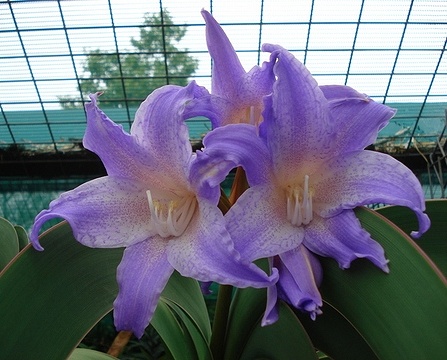Growing your The "Blue Amaryllis" Photo by Glenn Callcott
Growing medium -- Worsleya needs a loose, airy medium that drains very rapidly and provides plenty of moisture to the roots. For this reason, avoid ordinary soil. A good base medium is porous rock such as scoria, lava rock, pumice or other volcanic rock, approximately 5 to 10 mm in size (more toward the low end for younger plants, larger for older ones). Screen it of any tiny particles or very big pieces. It's often a good idea to mix in some organic material to retain extra moisture & nutrients, like small orchid bark, coco husks, or coco chips. The amount to use depends on the particle size. Coco husks should be about 10% of the total volume, and fine-grade bark or coco chips can be 20-30%. Many have reported success
using
long-fibered sphagnum moss Transplanting -- Leave your plant in its pot for 2 weeks after receiving it, so it can recover from being shipped. Moderate temperatures are best during this time, with bright shade or filtered sunlight, and protection from strong afternoon sun. After 2 weeks, you can transplant it to a pot about 5 inches wide (12 cm) and about 7-8 inches tall (18-20 cm) with drainage holes. Repot gently to avoid disturbing the roots, which are fragile. Keep the bulb exposed, and the roots buried. Give it bright, indirect light the first 2-3 weeks, then expose it to direct sun gradually, protecting it from strong afternoon sun for 2-3 months. Watering -- The roots should always stay moist, which usually means it will need water about once a day while young (older plants can handle less frequent watering). Water the entire surface, and use enough water so it runs freely out the bottom of the pot. During periods of slower growth, like during cooler temperatures, you may need to reduce the watering frequency. When you go on vacation, you can use an automated watering device - unless you can find someone reliable to water it for you! Fertilizer -- I give regular, light feedings, since the medium it grows in doesn't hold on to much nutrients the way soil does. You may either feed with each watering using a very dilute dosage, or feed about once a week using a stronger dose. An alternative is to mix some slow-release, granular fertilizer into the top inch (2.5 cm) of the surface and let it slowly dissolve with each watering. The disadvantage of granular fertilizer is that the pellets may dissolve slower than they would in soil. Choose a granular fertilizer labeled for indoor plants. It grows fine with most
general-purpose fertilizers. Choose one that contains micronutrients
(zinc, iron, etc) and calcium & magnesium. Liquid hydroponics fertilizer
works well, because it is easily absorbed and doesn't rely on soil microbes to
make the nitrogen available. I feed every 1-2 waterings with
General Hydroponics Flora fertilizer It's normal for an older leaf to occasionally turn yellow and then brown, but if it seems excessive, the roots may have been too dry. If you are certain they have been moist enough, the plant may need more nitrogen fertilizer. Climate -- Worsleya comes from an area with moderate temperatures and cooler nights, similar to San Diego's climate. Try to protect it from temperatures above 90 degrees F (32°C), or at least give it cooler temperatures at night. In warm conditions, keep the pot shaded, perhaps by placing it inside a second pot made of clay. In a warm greenhouse or room, put it on the floor where it's cooler. Outdoors, it can tolerate a couple degrees of frost, but i recommend keeping it above 35 degrees F (2°C), especially the first 2 years. Over about 40% humidity is preferred. Lighting -- Worsleya likes mostly-sunny conditions, with some protection from strong afternoon sun, especially in warmer conditions. The leaves will naturally arch over towards the sun as they grow. This might make some older plants tip their pot over! To prevent this, you might need to eventually place a weight on the pot to balance it. An alternative is to rotate the pot 180 degrees every 2-4 weeks, which will make the new leaves grow straight upward. After 2-3 years, repot it to a container about 7-8 inches (18-20cm) wide and about 10-12 inches (26-30 cm) tall. Avoid repotting again, as this will delay flowering. It doesn't mind being root-bound, provided that the roots stay moist. Encouraging flowering -- Once the base the bulb is almost 2 inches (5 cm) wide, expose the plant to night temperatures below 65°F (18°C), but preferably above 40°F (4°C). Feel free to contact me with questions. Have fun growing it! - Jeff Strange Wonderful Things
|
|||||||||


